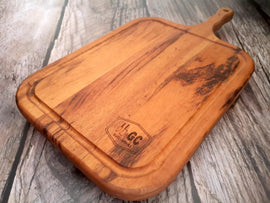by Jean Wilke Custom Knives
About
In South Africa we have become so accustomed to factory produced stainless steel knives that few people know and appreciate the hand-forged, simple carbon (steel) knife.
Carbon (Steel) knives are different from Stainless Steel knives in that they:
- Have no or less chromium, vanadium and other additives added to the iron during manufacturing.
- It is usually a simple mixture of Iron, Carbon and, in certain cases, a little bit of Chromium.
- Examples include:
- 1070
- 1084
- 1095
- 5160 (Spring Steel)
- 52100 (Bearing Steel)
- They can be heat-worked and forged, providing the blade smith a blank slate to work from, with the only limiting factor being their imagination.
- Most of the wonderful blades throughout history were simple, hand-forged carbon (steel) blades.
Due to it's chemistry they will oxidize in two ways;
Rust
Rust (Hematite) also known as "red rust" is a very aggressive oxidation that will weaken and over time destroy the blade if not taken care of.
Patina
Patina (Magnetite) also known as "black rust" during normal use is a non destructive process that is formed with normal use of the blade.
It is only the outer surface that is affected and forms an isolation layer, protecting the blade from "red rust". This patina is caused by the chemical reaction between the metal and certain materials like blood (meat), juices (fruits and vegetables) etc.
The patina is a blue-grey to brown that stains the knife. Over time this patina grows and makes each blade totally unique.
Like a bronze statue, the patina can be removed by light sanding or buffing but that will also remove the natural occurring protective layer that will result in red rust.
Your knife is part of you, it will develop with you and your adventures together will leave a reminder on its blade.
Why invest in a knife that can "rust"?
Forged blades are unique. It is only with great effort that a few of the best blade smiths will be able to reproduce a knife. The blade smith puts a little of themselves into each of the blades they make.
These blades are excellent cutters, slicers and stabbers and will retain their edge far better than the mass produced or commercial blades on the market. Easy to sharpen and keep finely honed. Tough as nails and can handle the challenges that nature and life presents it.
In our modern buy-and-discard lifestyle, having utensils that were expertly made by artisan craftsman still has a certain appeal.
Carbon Knife Care Instructions
Blades
Carbon and Damascus steel blades will rust if not cared for. To prevent rust, do not store your knife in it's leather sheath. The sheath is there to protect you from the knife.
The chemicals used in tanning of leather sometimes react with the moisture in the air leading to corrosion. This will also affect some stainless steel blades.
Apply blade oil or wax to your blade and wrap it in a soft cloth for long term storage. Use the sheath only when you are using or wearing your knife and wipe the oil or wax before using.
Never use your carbon steel knives to pry, dig or chop. Rather use an axe, pry bar or shovel.
The weakest part of any knife is the tip, take care of the tip and the rest of the blade will follow.
Never throw knives unless they were specifically designed for throwing.
Some carbon steel blades are blued. Bluing is a very thin patina that can eventually wear away, leaving a grey metal finish. Bluing is used to lightly protect or cosmetically enhance the blades and they act as rust inhibitors, but will not prevent rust.
Cleaning
Do not wash your hand made carbon knife in a dishwasher.
Wash your blade by hand in warm soapy water and dry immediately. Do not leave it to soak in the water and do not leave it to air dry on the drying rack.
Oil the knife immediately after drying with a vegetable oil or the GrootCecil blade oil.
If rust spots appear, rub the blade with a metal polish like brasso or a very fine steel wool, then oil the blade.
Do not confuse rust with a patina or stain that may appear on your knife after cutting something acidic. This is normal and adds to the character of your knife.
Do not use oil with silicon as it is known to cause rust. Do not leave knives and sheaths in direct sunlight. Ultraviolet light oxidizes woods and bleaches the colour of some gemstones.
Handles & Sheaths
Wood handles usually benefit from a light coating of furniture or conservation wax and a good hand rubbing.
Heat bakes the protective oils out of most hardwoods and leather and weakens adhesive bonds. Do not use any kind of oil on the sheaths as this will cause them to soften, weakening their protective function. This can also lead to softening of glues, sealants and dyes. Prolonged exposure to the sun can also destroy knife sheaths.
"Take care of your knife and it will take care of you"
Visit Jean Wilke Custom Knives online:



